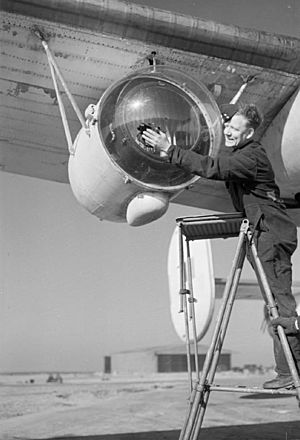Leigh Light facts for kids
The Leigh Light (pronounced "Lee Light") was a special powerful searchlight used by the British during World War II. It was designed to help planes find and attack German U-boats (submarines) at night. This invention played a big role in the Battle of the Atlantic, helping the Allies protect important supply ships.
Contents
How the Leigh Light Helped Spot U-boats
Before the Leigh Light, planes used a special radar called Air-to-Surface Vessel radar (ASV) to find U-boats at night. The problem was that the radar couldn't see targets very close up, about 1 kilometer (0.6 miles) away. This meant that when a U-boat got too close to the plane, it would disappear from the radar screen. The pilots couldn't see the U-boat to attack it.
Solving the Nighttime Problem
A British officer named Wing Commander Humphrey de Verd Leigh came up with a clever idea. He suggested putting a very strong searchlight on the planes. This searchlight was 24 inches (about 60 cm) wide. The plan was to switch on the searchlight just as the U-boat was about to disappear from the radar.
Surprising the Enemy
This sudden bright light gave the U-boat crew almost no time to dive underwater and hide. The plane's bombardier (the person who drops bombs) could then clearly see the submarine and attack it. The Leigh Light was first used in June 1942. It was so successful that German submarines had to change their tactics. They started charging their batteries during the daytime instead, so they could at least see planes coming.
The Radar Battle: Allies vs. U-boats
Germany soon developed a device called Metox. This was a radar warning receiver that could detect when an aircraft's radar was nearby. Metox could "hear" the radar signals from much farther away than the aircraft's radar could "see" the U-boat. This often gave the U-boat enough warning to dive and escape before the plane got close enough to use its Leigh Light.
Allies Fight Back with New Radar
The Allies expected Germany to try and counter their advantage. So, they introduced a new and improved radar called ASV Mk. III radar. This radar used a different type of signal, called "centimetric" waves, which Metox could not detect. This new radar, combined with the Leigh Light, helped the Allies regain control of the battle against the U-boats.
Germany's Final Counter-Move
Germany later developed another detector called Naxos to counter the new centimetric radars. However, by this time, the U-boat force had already suffered too many losses and was severely weakened. The Leigh Light, along with advanced radar, played a key role in protecting Allied shipping during World War II.
Images for kids
See also
 In Spanish: Foco Leigh para niños
In Spanish: Foco Leigh para niños





